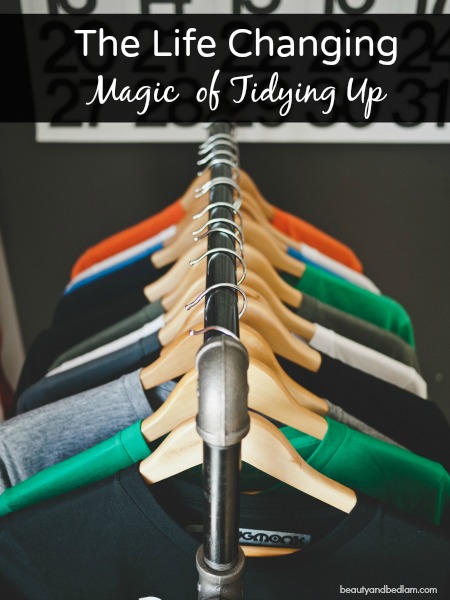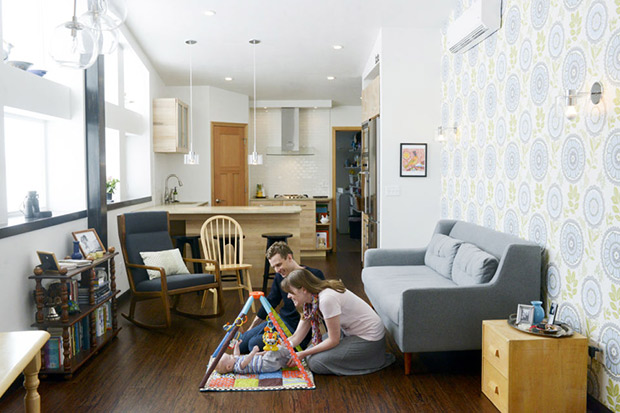Since my Clutter Countdown Challenge, that began in October and continues to trickle on, I’ve come to realize that it’s an issue in my life that I will continually need to tackle and address. Everyone has something in their life that is just that little thorn in their flesh and for me, it’s this. Therefore, when I see something that jumps out at me, I’ll share it.
At Barnes and Noble the other day, a title did just that. I’m pretty picky with my titles, so when I see the words MAGIC and TIDY in bold, you can bet I’m biting. Drat, that marketing.
The Life-Changing Magic of Tidying Up: The Japanese Art of Decluttering and Organizing sucked me in.
I admit, so many phenomenal insights hit me, ones I KNOW I NEED to apply in our own home, but instead of pondering my next steps, guess what I did right then? I googled the author’s name and the question, “Does Marie Kondo have kids?”
HA! Yes, I admit I just needed a little validation. She doesn’t, but when Katie emailed me the following week and asked if I had heard of the book, I knew I needed her insight because I’m jaded. (When I read the author’s major suggestion was don’t try and tidy a little every day, it has to be done all at once, I googled the kids question. ;))
So Katie is taking it away.
How many bags of clutter could you stuff and haul out of your house? Marie Kondo is quite certain that she can have you hauling out dozens if you strictly adhere to the techniques she describes in her book,
Have you heard about it?
Kondo’s popularity is sweeping through the US right now. Her book’s been on the bestsellers’ list since October, challenging readers to ask themselves one simple question about their belongings:
Does it tokimeku—does it spark joy?
Kondo (30) and I are about the same age, and recently I think we’ve probably filled a comparable number of garbage bags, both our things and other people’s.
My husband and I live in a 720 square foot home in the back of an airplane hangar. But before we could start building, we had to clean out the hangar. We bought it as-is from a Depression era pilot, which meant the entire hangar was filled to the brim with everything you could imagine: hundreds of used spark plugs, tires, enough lightbulbs for everyone in the county, and an untouched emergency food stash, which equaled almost two years’ worth of food for one adult male.
It took us months to empty the place enough to even begin construction of a tiny home in the back, and we were on a first name basis with everyone at the thrift store and even the dump and recycling center.
But we did it!
Now we have a son sharing our 720 square foot space. It’s plenty of room for all three of us … as long as we constantly keep tabs on what we bring home.
As Jen and I discuss ideas for the Clutter Countdown with you, I thought it might be useful to know how this book that’s getting so much buzz might help you (and how it might not).
1. Tidy a little a day and you’ll be tidying forever.
Kondo argues that “tidying is a special event. Don’t do it every day.” Do it in one enormous swoop, and be done with it. Boom.
2. Sort by category, not location.
Don’t tidy up a corner of the house, she argues. Pick a particular item like clothes or papers. More specifically, she wants you to go in this order: clothes, books, papers, miscellany, and then things with sentimental value.
3. Never pile things.
She stores absolutely everything vertically–from sweaters to even her laptop. This Wall Street Journal article has great illustrations on how she folds her clothing. (I’ve been storing my shirts the same vertical way for years, and it really is something I highly recommend. You can actually see what you own.)
4. Storage experts are hoarders.
Sorry folks. Organized clutter is still clutter.
5. Toss cards, photographs, and sentimental objects ruthlessly.
(During our Clutter Countdown challenge, we’ve addressed some great ideas and suggestions for parting with sentimental baby clothes here, as well as decluttering sentimental objects here.)
I paraphrased that a bit. Being an avid journaler and storycatcher, this part of her book really bothered me. She urges you to read your mail over the recycling bin. Open a card from someone, read it, then immediately toss it. In a culture where handwritten notes are so few, should we treat them with such carelessness? Whenever I receive a meaningful card, I tuck it into this. When my son gets something, we put it in this. Old letters from grandparents, photos with friends, and even letters from siblings away at summer camp years ago–those pieces of memorabilia all tell a story about who we are. That shouldn’t be discarded.
I feel like Kondo has some really amazing ideas. Her advice on clothing is excellent. I’m confident you’ll walk away with some great tips for making your closet more enjoyable. If you’re also battling with clutter other people in your house create, she’s got some great insight on how to handle it.
However, I wish that Kondo dove into more detail, especially with paperwork and kitchen items. If you are a book lover, you really don’t want to see her advice there. I know we all keep more books than we should. (Remember this amazing book decluttering strategy? It works wonders.)
If you want to make huge decluttering change, I highly recommend at least reading this book! The Life-Changing Magic of Tidying Up: The Japanese Art of Decluttering and Organizing
Just remember:
Keep room in your home for the things that make you you. It’s your sanctuary.
I’d love to hear your thoughts.
Think you could remove bags and bags of belongings from your home?
What tips and tricks would you suggest for tackling clutter? Kondo’s method?



I have read many articles on this book and I am sure it works wonders for some people. But then there are people who LOVE things. I am one of them. it thrills me to no end to drag out box after box of holiday decorations for every single holiday. I draw energy from my overstuffed bookshelves. Granted, my apartment might not be Southern Homes and Gardens ready at any given moment but it works for me. Sometimes lived-in is the best look for any home.
My husband, who is a big time hoarder, got this book a couple of months ago. He has used it to organize and donate his clothes, some of which were 20 years old. I had tried to hint several times that he never wore most of them, but it took a book to get him to move them. He still has way too many, but maybe someday he will get to the books and other things!!
Good post!
I would need a little more clarification on a few of those ideas. Especially #1 and #4! “tidying is a special event. Don’t do it every day.” Do it in one enormous swoop, and be done with it. Boom.” —If I follow THAT, I would NEVER have a tidy home!! The STUFF doesn’t just STAY put away…..weird, I know. I have questioned if I actually have ornery poltergeist, but it turns out I just have kids and a husband!
I could never toss pictures. Days and people that stand still in time are priceless and needed for our children to understand our lives. As for cards, I keep cards too, I may only keep the front of some cards and use it as a craft (think xmas cards), or us it as a note card to leave a note for someone at home. I love buying cards, but dislike the outlandish prices, so if someone spent the time and money shopping for the card, I am going to make good use of it. If only I could figure out why I keep so much of everything else. lol
I checked this book out from the library and read it–and prayed something was lost in the translation. This woman is a little harsh for my tastes, (her tone is a lot like SCOLDING!) and OBVIOUSLY lives alone! While I understand tackling things as a category, rather than room by room, I have no desire to live quite as sterile of a life as she does. Nor would I still have a relationship with a sibling as ruthless with my belongings as she was to her family! There are some good idea to be gleaned out of this book, but like many organizing/decluttering books, one theory does not fit all! My advice to other readers would be to take what works for you, and leave the rest.
@Jean,
The tone is a bit off-putting. I was wondering if maybe that has to do with the translation. When my husband is speaking Czech with his mom on the phone, I swear they’re arguing. But that’s just because the tone sounds harsh. Could written tone convey the same, I wonder.
@Jean,
Jean you hit the nail on the head, STERILE. That is exactly what I feel this woman is embracing. Some folks may like to love that way, I just don’t know any of them.
Everyone has a different personality-God made us that way. What tugs at one persons heart means nothing to someone else. For me, the “all or nothing” approach is geared for more of a “Type A” person. For the one who loves pictures (on photo paper!) and has lots of sentimental items, do these things bring you down or bring you joy? I wish someone would write a book to help everyone, instead of feeling like its “my way or the highway.” I DID part with some things during a move last year, and wish I had those items back. A friend used to say “if it’s not eating anything” as in, you are not paying to keep it (storage) then it’s okay. If it is an issue, start with 5 or 10 things a room. I was raised by a Mom who called our house “Early St. Vincent de Paul.” Anything else was “too clinical!” All these years later, I HAVE turned into my Mother! Living in something that looks like a doctors office is not for me. One toss at a time, I guess. And I DO keep a bag by the front door for Goodwill..another to consign. Blessings to all- Ann
I agree wholeheartedly with a lot of what she says! We toss cards ruthlessly, my mom kept binders of cards for us growing up and while it was nice and memorable, it’s bulky and takes up a lot of space! We will, however, keep in a box the cards that have extra special messages in them (and not just another birthday card :D).
I laughed out loud about the hoarders part! YES!
Also, if it doesn’t make me smile then out it goes when it comes to artwork the kids do. They produce SO MUCH and sometimes its the same over and over but slightly different or better, but if it doesn’t induce a smile, I don’t keep it.
We’re seriously decluttering over here in anticipation of a move, but we do it on a seasonal basis as well.
While I don’t like the sterile look she seems to promote at times – sorry, I love me some books! 🙂 – I find the idea of decluttering once and for all as pure genius!
Who wants to constantly declutter? 🙂
I’m following her method by working in batches: I’m at the clothes stage. In order to not create messes all over the place I’m working on dresses, then skirts, than underwear… Love it!
The clothing idea is the one I MUST tackle. Now I won’t do it quite as she suggests, but I need to implement some of it. Love your suggestions for taking one group at a time.
I’ve been “studying” her book and love it. But I agree, follow your heart on some things. I am a hoarder so you may not want to listen to me.
Another problem I have, being a hoarder I can’t take everything from one category and lay it on the floor. I don’t have enough floor. But I’m modifying the idea to fit my space. What I’ve done so far is beautiful and it’s working. I haven’t regressed in those areas. I probably will take the full 6 months to finish. But I’m also having a ball finding things I haven’t seen in ages.